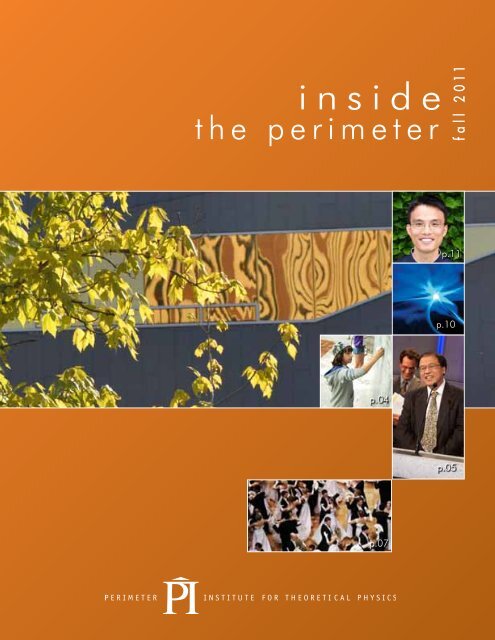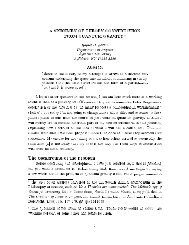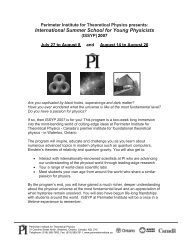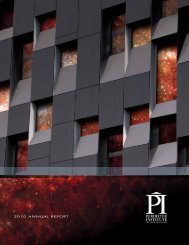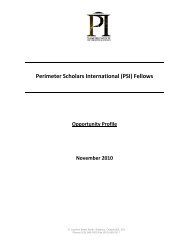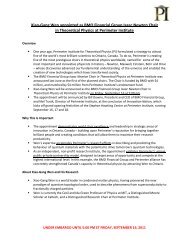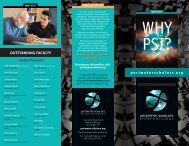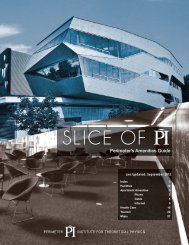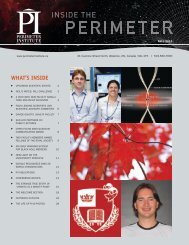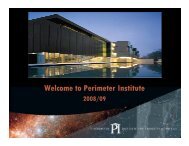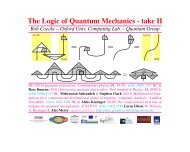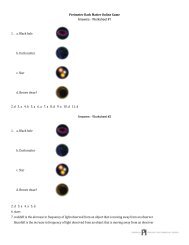i n s i d e - Perimeter Institute
i n s i d e - Perimeter Institute
i n s i d e - Perimeter Institute
You also want an ePaper? Increase the reach of your titles
YUMPU automatically turns print PDFs into web optimized ePapers that Google loves.
A Grand Opening“From this building, we will inform, educate, and excite millionsof people about the power of physics. We will train the futureleaders of our field here. And we will do ambitious research intothe deepest questions in physics, combining intellectual daringwith uncompromising rigour. We look to change the world.”—Neil Turok“It is a tremendous honour to have this expansion of <strong>Perimeter</strong><strong>Institute</strong> named for me. … The centre’s clear focus, inspiringdesign, and productive research interactions will no doubt attractmany leading scientists here. <strong>Perimeter</strong> is on a great path, and Iam delighted to be associated with it.”—Stephen Hawking“Today we are marking the latest milestone on <strong>Perimeter</strong>’sincredible journey. In ten short years, <strong>Perimeter</strong> has gone froman ambitious idea, to an upstart organization in a temporaryspace, to a rising international force in theoretical physics. Withthis expanded research facility, we mark our commitment to gofurther still.”—Mike Lazaridisfall 2011 03
What is Emergence?When we see some collective property of a systemthat does not belong to its elementary constituents,we say that this property is emergent.Studying emergence is like watching the GrandWaltz at the debutantes' night in Vienna fromabove. There is something moving through theballroom, but it is not the dancers, who more orless stay where they are (since debutantes' night isvery crowded, and there is not much room to movearound — see Fig.1). What is moving around isa pattern, a collective motion of all the dancersin the ballroom. A physicist would be temptedto call this something that is moving around theroom a 'waltzon', and would say that the waltzon isemergent.Or consider a physics example: phonons areparticles that carry sound inside a crystal. It’snatural to ask “what are the phonons made of?” –but it’s the wrong question. If we look at a phononvery closely, we see nothing at all: only the atoms inthe crystal. Phonons are a collective motion of theseatoms, so they are not made of anything.One of the great questions of contemporaryphysics is, “What in nature is emergent and whatis fundamental?” If phonons are emergent, whatabout all the other constructions of physics?Electrons, protons, photons, the other so-calledgauge fields, even that trickster gravity − arethey really fundamental? Are they really the basicbuilding blocks of nature? Perhaps they areemergent, just like phonons.It is important to understand that if such particlesare emergent, the precise mechanism that makesthem emerge may not be important. With ourwaltzon, we do not care about the details of thedresses of the dancers, and we do not even careabout the details of their movements, as long asthey follow the waltz tempo and some other rules.As long as they dance some waltz, we will seewaltzons.So it is with physics: a somewhat different underlyingsystem would produce − would make emerge −the same behavior. This insensitiveness to detailsmeans that we don’t need to accept the beauty andsimplicity of nature as something given. A messy,complicated system might make emerge the beautyand simplicity that are the hallmark of the laws ofphysics.This is a profound shift in a paradigm we’veheld since Parmenides and Plato convinced usthat substance was the most fundamental notionnecessary to describe the world. For two and a halfthousand years we’ve followed (with some detours)the atomic hypothesis: the belief that there areelementary particles whose behavior is governed bysimple laws, and thatif we truly understoodthese particles and Figure 1these laws, we wouldunderstand all nature.The laws were simplebecause they weresimple – there was noexplanation for it.Emergence changesthis. It tells us thatsimple laws canemerge like thepatterns of a dancefrom messy andcomplicated systems.If we can understandthat process, we canexplain why there isbeauty in nature.This attitude canchange the way wethink of some ofthe most importantproblems in physics,like understandingblack holes. The emergence point of view hints thatstudying microscopic models is not the right thingto do, because the black hole might be a collectivephenomenon. The most important concepts inphysics, like symmetry, are perhaps not set in stone,but are emergent properties, what we call theproperties of a phase.For 2,500 years, the relevant question was: “Whatare things made of?” The new relevant question is:“How do things organize?”—Alioscia Hamma<strong>Perimeter</strong> recently held a conference on “Emergence and Effective Field Theories.”Look for the talks on PIRSA, www.pirsa.org/C11034.fall 2011 07
i n s i d e t h e p e r i m e t e rp i n e w sWhere the Rules Come FromThe rules of quantum mechanicsare powerful: they are the bottomrung of a vast ladder of science,and the fundamental tools that let usbuild everything from microchips topowerplants. But where do they comefrom? Traditionally, physicists wouldanswer, “That’s just the way the worldis.” But is that all we can say? Or is itpossible to derive quantum theory frommore fundamental principles?PI Postdoctoral Researcher GiulioChiribella and his colleagues GiacomoMauro D’Ariano and Paolo Perinottifrom the University of Pavia, Italy, havedevised a framework for grapplingwith such deep questions. In theirpaper “Informational Derivation ofQuantum Theory,” recently publishedin Physical Review A and highlightedby the American Physical Society, theresearchers show that quantum theorycan be derived from six fundamentalassumptions about how information isprocessed.This work is in the spirit of JohnWheeler’s belief that “it” — physicalreality — comes from “bit” —information. That, as Wheeler wrote,“every item of the physical world has atbottom — a very deep bottom, in mostinstances — an immaterial source andexplanation; that which we call realityarises in the last analysis from the posingof yes-no questions.” The universe is acomputational machine, using the ruleswe call physics to derive its next statefrom its current one. Information sits atthe core of this computer, just as it sits atthe core of an ordinary computer.The paper by Chiribella, D’Ariano andPerinotti explores the ways in whichthe universe-computer handles suchinformation. The researchers assumefive elementary axioms: causality, perfectdistinguishability, ideal compression,local distinguishability, and pureconditioning. These axioms definefive ordinary features of information,and are fulfilled both by classical andquantum theory. The real breakthroughis the definition of a sixth axiom, called“purification” — an axiom so importantthat Chiribella et al elevated it to thelevel of postulate.Purification states that a system withuncertain properties — what theauthors call a “mixed state” — can bemodelled as part of a larger system withdefinite properties — a “pure state.”For instance, consider a spin-zero piondecaying into two spinning photons.Each photon is in a mixed state — itsspin could be up or down, and thereis no way to predict which. The pair ofphotons together, though, comprise apure state in which they must always spinin opposite directions. If a system is in apure state, then it is impossible to knowanything more about it.In other words, the purification postulateimplies entanglement. Pushed a littlefurther, purification also explains whyquantum information can’t be copiedwithout destroying it but can be“teleported” — that is, replicated at adistant location after being destroyed atits point of origin.By combining the purification postulatewith the other five axioms, Chiribellaet al were able to derive the entiremathematical formalism behindquantum mechanics, and presentquantum theory in simple physicalterms, without the need for abstractmathematical jargon. The rules comefrom somewhere after all.Having the deep principles from whichone can reconstruct existing theoryis exciting, but does this work opennew avenues? Maybe. In the way newgeometries were born when Euclid’s08 Fall 2011
fifth postulate was questioned, definingthe postulates of quantum informationgives physicists exact places to zero intheir attention, which could lead to thediscovery of alternative theories.For instance, one of the most radicalchanges to quantum theory would beto drop the assumption of causality:the idea that the future cannot affectthe past. (Or, to put a quantuminformation spin on it, the idea thatinformation propagates in a preferreddirection, identified with “time”.) SeveralElla Secararesearchers at <strong>Perimeter</strong> — includingChiribella and quantum theorist LucienHardy — are developing frameworksthat do not presume underlyingspacetime or fixed causal structures.This may open new doors for mergingquantum theory and general relativity.—Erin BowFurther Exploration:• G. Chiribella, G. M. D’Ariano, P.Perinotti, “Informational Derivationof Quantum Theory”, Phys. Rev. A84, 012311 (2011), http://pra.aps.org/abstract/PRA/v84/i1/e012311• G. Chiribella, G. M. D’Ariano, P.Perinotti, “Probabilistic Theorieswith Purification”, Phys. Rev. A 81,062348 (2010), http://pra.aps.org/abstract/PRA/v81/i6/e062348• C. Brukner, “Questioning the rulesof the game”, Physics 4, 55 (2011),http://physics.aps.org/articles/v4/55• D. Powell, “Quantum Theory getsphysical”, ScienceNews, http://www.sciencenews.org/view/generic/id/332557/title/Quantum_theory_gets_physicalRelated works:• L. Hardy, arXiv/quant-ph/0101012(2001).• B. Dakic and Č. Brukner, in DeepBeauty, edited by Hans Halvorson(Cambridge University Press, NewYork, 2011)• L. Masanes and M. P. Mueller, NewJ. Phys. 13, 063001 (2011).Fair Dice“Not only does God play dice withthe universe,” says Roger Colbeck.“His dice are fair.”Colbeck, a postdoctoral researcher at<strong>Perimeter</strong>, recently published a paperentitled “No extension of quantumtheory can have improved predictivepower,” in Nature Communications.“If quantum theory is correct, thenit is also complete,” says Colbeck.“There cannot be a better descriptionof the outcomes.”The probabilistic nature of quantum predictions troubled many earlyquantum scientists, including Einstein, who famously objected that “Goddoes not play dice with the universe.” In the 1930s, Einstein, Podolsky, andRosen (among others) argued that even if quantum mechanics is a correcttheory, it might not be a complete one: there might be a deeper reality –perhaps hidden variables that if measured could allow scientists to predictoutcomes without quantum uncertainty. This proposition is so famous thatit’s known by its acronym: EPR.In the 1960s, J.S. Bell’s eponymous theorem showed that no local hiddenvariables exist which would take all the uncertainty out of quantummechanics. But can we take out any of it? That’s been a door left ajar forhalf a century.Colbeck – working in collaboration with Renato Renner from ETH Zurichin Switzerland – has closed that door. This new research shows that nouncertainty can be removed.This conclusion is reached partly via a connection to quantumcryptography. Imagine two people, Alice and Bob, trying to establish ashared key that no one else knows, which they might use to send secretmessages to each other. In quantum cryptography, the key might begenerated by first sharing and then measuring a series of entangledparticles. If a “bad guy” sits in between Alice and Bob, the only way he cangain information about the key is by disturbing the entanglement. Hence,Alice and Bob can detect any attempted interception.The intriguing thing, to Colbeck, is that Alice and Bob can generate asecure key without needing to know anything about how the measurementdevices operate. In an extreme case, one might imagine that the bad guysomehow got his hands on the device, and corrupted it as he pleases.Remarkably, this does not present a problem: even if the bad guy designsand supplies the device himself, Alice and Bob can perform tests toestablish that the measurement outcomes are nevertheless secure.That’s called device independence, and to Colbeck, it’s a powerful tool. Itlets you replace “the bad guy” with “the universe.” In this way, the deviceindependentcryptographic result can be used to derive a result in quantumfoundations.In other words: If there were hidden variables, as EPR proposed, then theuniverse could use them to determine what the device would output. Sinceno one and nothing can predict – or even slightly influence – outputs in thisway, then there are no hidden variables, not even weak ones, and quantumpredictions generally cannot be improved.—Erin BowFurther Exploration:“No extension of quantum theory can have improved predictive power,”Roger Colbeck & Renato Renner; Nature Communications, Volume 2,Article 411; 02 August 2011fall 2011 09
i n s i d e t h e p e r i m e t e rp i n e w sBreaking New Paths:Templeton Frontiers Program EstablishedThe new Templeton Frontiers Program at <strong>Perimeter</strong><strong>Institute</strong> for Theoretical Physics aims to catalyzepath-breaking research by encouraging youngscientists to pursue ambitious and daring ideas.The integrated program, supported by a $2 million grantfrom the John Templeton Foundation, centres on threeresearch areas which are key to major advances in ourunderstanding of the universe: quantum foundations andinformation, foundational questions in cosmology, andthe emergence of spacetime.“<strong>Perimeter</strong> <strong>Institute</strong> researchers have already madesubstantial contributions to each of these fields and arehelping forge new connections between them,” explainsNeil Turok, <strong>Perimeter</strong>’s Director. “We hope our newpartnership with the Templeton Foundation will attractbrilliant young people into foundational research andset an example by providing the environment, support,encouragement and mentorship they need to pursuebreakthroughs. Together, <strong>Perimeter</strong> and Templeton areaiming to advance the way the most ambitious andoriginal theoretical physics is done.”The Templeton Frontiers Program at <strong>Perimeter</strong> <strong>Institute</strong> willsupport the following:• Three exceptional young postdoctoral researchers asTempleton Frontiers Fellows• A program bringing Distinguished Research Chairs,globally pre-eminent scientists working in these fields,to <strong>Perimeter</strong> to provide mentorship and inspiration• Templeton Frontiers Conferences, Workshops, andColloquia in these fields, held at <strong>Perimeter</strong> <strong>Institute</strong> toshare research and spark new collaborations• Research projects of outstanding undergraduate,Masters, and PhD students at <strong>Perimeter</strong>, and VisitingGraduate FellowsThe Templeton Frontiers Program is made possiblethrough the John Templeton Foundation’s Science &the Big Questions funding program, which supportsinnovative approaches to foundational questionsthroughout the mathematical and physical sciences.—Natasha Waxman10 Fall 2011
i n s i d e t h e p e r i m e t e rp i n e w sA Chat withGuifre VidalGuifre Vidal recently arrived at PI as asenior Faculty member in condensedmatter. His past honours include anAustralian Research Council FederationFellowship, a European Union MarieCurie Fellowship, a Sherman FairchildFellowship, and a Distinguished ResearchChair at <strong>Perimeter</strong> <strong>Institute</strong>. Here he tellsus a little bit more about himself.NW: Welcome! Please tell me a bit aboutyour background, and where you’recoming from.GV: I grew up in Barcelona, wherein 1999 I obtained a PhD in Physicsfrom the University of Barcelona. I didtwo postdocs, one at the University ofInnsbruck, Austria, and one at the <strong>Institute</strong>for Quantum Information at the California<strong>Institute</strong> of Technology. From 2005 anduntil recently, I was a Professor in theSchool of Mathematics and Physics at theUniversity of Queensland, in Brisbane,Australia, where I built a research groupin quantum information, computationalphysics, and condensed matter.NW: Well, we’re glad to have you here at<strong>Perimeter</strong>! How are you settling in?GV: <strong>Perimeter</strong> has been very welcoming.And I like Canada. One thing I like is thatit’s a really multicultural country and that’sperfect for my family. I have a Europeanand now Australian background and mywife, Dora, is originally from Hong Kongand then Australia. We sense that we willfit naturally here. Our son Marc is justseven months old, and growing fast. He’sbusy learning Cantonese and Catalan —well, that’s what we think he’s doing. It’sall good, except that he’s going to have aCanadian accent instead of an Australianone. Yeah, I’m very excited to be here. I’llprobably stay excited until the first snowfalls.NW: Er … Have you ever lived in a snowyclimate?GV: My first postdoc was at Innsbruck— it’s in the Alps. It’s like here, but withmountains. I don’t seeany mountains here.Actually, I’ve been toPI several times before.Last May was the first time when therewasn’t any snow. It was the first time I sawpavement here and thought, “Oh, there ispavement on the roads.” Until then, I wasunder the impression that the roads inWaterloo were made of snow.NW: Buy a good shovel — you’re goingto need it. Snow aside, what attracted youto <strong>Perimeter</strong>?GV: <strong>Perimeter</strong> lets me concentrate onresearch. That’s what I prefer to do. Iprefer to stay simple so that I can spendmy time thinking about physics, asopposed to having to manage a largeresearch group.NW: Can you give us the broad strokesof your research? What are you interestedin?GV: The long-term goal of my researchis to better understand quantum manybodyphysics and quantum entanglement.I’m very interested in understanding whathappens when you put lots of microscopicdegrees of freedom together with simpleinteractions. We get collective behaviors,emergent behaviors — but exactly whatemerges, and how? That’s often still kindof a mystery. I’d like to develop bettertheoretical tools to derive or predict theseemergent behaviors starting from themicroscopic descriptions.NW: A mystery that crops up in a numberof different fields ...GV: That’s right. I started studyingentanglement in the context of quantumcomputing, where it’s used as a resourcefor quantum information processing.Nowadays, entanglement is alsointensively studied in the broader contextof quantum many-body physics. Forinstance, entanglement offers a naturaltheoretical framework to study quantumphases of matter, which would usuallybe considered part of condensed matterphysics. The quantum many-body problemalso has implications for quantum fieldtheory, string theory, quantum gravity, etc.It’s exciting to do work that could havesuch broad implications.NW: What are you working on right now?What’s got you excited?GV: What I’ve been doing lately is workon tensor networks. A tensor network is anansatz* for the many-body ground stateon a lattice system. One particular type oftensor network, based on renormalizationgroup ideas, is a promising step towardsanswering the question I asked beforeabout deriving emergent collectivephenomena starting from a microscopicdescription. In addition, some colleagueshave recently shown how to generalizetensor networks from the lattice (spinsystems) to the continuum (field theories),which is leading us towards new nonperturbativeapproaches to quantum fieldtheories.NW: So how did you become interested inphysics in the first place?GV: I have no idea. It just seems I’vealways been interested in it. I do knowthat, as a boy, I was very happy the dayI learned that my father had studiedphysics. I had been very interested in thesebooks that talked about physics stuff buthad not realized that it might have beenan inherited passion. I never consideredanything else. That doesn’t mean thatI was completely focused on physics,just that pursuing an academic careerin physics appeared as a natural path.Actually, laziness has probably been thesingle most influential factor shaping thispath. For instance, I did not decide that Iwanted to go to university, or do a PhD, oreven start a first postdoc. In each of theseoccasions, what I really decided was that I12 Fall 2011
Kudos to ...<strong>Perimeter</strong> <strong>Institute</strong> congratulates Freddy Cachazo, who isthis year’s winner of the Rutherford Memorial Medal inPhysics from the Royal Society of Canada.didn’t want to grow up and face reality —I didn’t want to take a real job and haveto work. In hindsight, this was quite stupid— I ended up working nearly as hard. Butby then it was too late: nobody outsideacademia would give me a job. I admirepeople who make decisions. I’m not oneof them.NW: That’s remarkable. You never hadany doubts?GV: Well … The other day I went to pickup a cargo van, to go to the airportto collect some boxes with personalbelongings from Australia. I had so muchfun driving down the highway. And thatmakes you think … Anyway, the followingday I had to return the van to the rentalcompany, and that was kind of sad; itfelt like a kid saying goodbye to his bestfriend. I miss that cargo van.NW: So, if physics doesn’t work out, youcould be a trucker.GV: Yeah! Absolutely! Although, when Ithink about it, I’ve never been a very gooddriver …–Interview by Natasha Waxman*Editor’s note: An ansatz is a simplifiedmathematical model that makesassumptions that can be tested later.One of the Royal Society’s top honours, the RutherfordMedal recognizes outstanding research in any branch ofphysics. This is not Cachazo’s first such prize: In 2009, hewas awarded the Gribov Medal of the European PhysicalSociety.Cachazo is a superstring researcher working to understand nature’s mostfundamental constituents, but his work has attracted attention for its immediateusefulness in high-energy physics.Experimental high-energy physicists use accelerators to smash subatomicparticles together at near light speed, causing interactions which create newparticles. Outgoing particles are tracked,and these data are compared againstpredicted values to determine whethercurrent theory accounts for all of thephenomena observed.To set predicted values, scientists mustcalculate scattering amplitudes: theoreticalpredictions of what outgoing particlesare produced in what numbers in highenergy collisions. Calculating scatteringamplitudes has always been challenging,Photo credit: CERN but as accelerators have grown morepowerful, the problems have mounted.With the launch of the Large Hadron Collider at CERN, calculating scatteringamplitudes with traditional methods became practically infeasible.This is where Cachazo enters the picture. Drawing together ideas fromquantum field theory and complex analysis, Cachazo and his collaboratorsdeveloped new techniques for calculating scattering amplitudes that yieldresults far more simply and efficiently than was previously possible. Thesetechniques have already been widely adopted by experimentalists, and havebeen hailed as breakthroughs.But beyond its immediate utility, Cachazo’s work has also initiated a profoundshift in our understanding of quantum field theories. In developing the newmethods, Cachazo and his collaborators have uncovered surprising newmathematical structures. These structures may be clues that will lead to a muchdeeper understanding of how elementary particles arise, and the structure ofspacetime itself.Graduate student Hoan Dang has won a Vanier Canada Graduate Scholarshipfrom the Government of Canada. The scholarship is valued at $50,000 per year,for three years.Former graduate student Rowan Thomson has received a 2011 John CharlesPolanyi Prize in Physics from the Government of Ontario. The prize is valued at$20,000.fall FALL 2011 13
i n s i d e t h e p e r i m e t e rn e w p o s t d o c p r o f i l e sHaipeng AnPrimary research area: Particle physics.Last stop: University of Maryland, USA.What amazes you about theoretical physics? That the complex universe can be understood bymathematics invented by human beings.Favourite physicist: Einstein.Favourite film: I like science fiction films. My favourite is Independence Day.Looking forward to: A group of strong and friendly physicists to discuss physics. A quiet small cityto live. Also, my wife will come to Waterloo in a few months – I am looking forward to that!Ido Ben-DayanPrimary research area: Cosmology and high energy physics.Last stop: Ben-Gurion University of the Negev, Israel.Proof I was a geeky kid: In sixth grade, I wrote that I wanted to invent a “new theory of relativity”without having any idea what that meant.Physics role model: Gabriele Veneziano.Looking forward to: Working in a new and fascinating environment with new people and friends.When I’m not doing physics, I play American Football – full tackle, full gear. I hope I can find anamateur league near Toronto, and that it will agree to take an out-of-shape, aging defensive end/linebacker.Eugenio BianchiPrimary research area: Quantum gravity.Last stop: Centre de Physique Théorique de Marseille, France.What amazes you about theoretical physics? That we can use what we know about the world topredict something new about it, before observing it. It tastes like magic.I got into physics because … As a kid, I was fascinated by biology. I started to explore, made myfirst little experiments and observations, and kept asking why. If you ask why too many times, youend up doing theoretical physics.Favourite physicist: I can’t hide the fact that I love Richard Feynman’s style.When I’m not doing physics, I like jogging, hiking, taking nature pictures, and obviously cooking,specifically Italian cuisine.Oliver BuerschaperPrimary research area: Quantum information and condensed matter physics.Last stop: Max-Planck-<strong>Institute</strong> of Quantum Optics in Munich, Germany.Proof I was a geeky kid: In high school, I was quite amazed by the book Surely You’re Joking,Mr. Feynman! However, I had already loved both physics and percussion instruments even beforelearning about the eccentric glory of Richard Feynman’s life.Looking forward to: The great research and social environment that PI is famous for. In particular,I’m looking forward to lively discussions about physics in front of a crackling fireplace.When I’m not doing physics, I like music, in particular playing the cajón [box drum], as well asmartial arts, basketball, and cooking.14 Fall 2011
Shih-Hung (Holden) ChenPrimary research area: Cyclic cosmology, modified gravity, two-time physics.Last stop: Arizona State University, USA.Proof I was a geeky kid: When I was seven, I did an experiment to prove there is about 1/5oxygen in the atmosphere, by watching the amount of water moving up in an upside down glasssubmerged in a water tank with a candle burning in it.Inspiring physics book: Steven Weinberg’s book, Dreams of A Final Theory.Favourite movie: A Beautiful Mind.Looking forward to: Discussing physics and making friends with people. Also, I like coffee verymuch. I am very excited about going to a place with tons of free coffee – looking forward to manycoffee discussions.Lukasz CincioPrimary research area: Quantum information and condensed matter physics.Last stop: University of Queensland, Australia.I got into physics when … As a postdoc, I should probably say that physics has been in the centreof my interests forever but, honestly, it used to be maths. My father gave private lessons. When Iwas a boy, I attended them with students who were much older than me. I was amazed by roots,trigonometrical functions and integrals.Physics inspiration: Richard Feynman. As a young student, I was fascinated by his famous lecturesin physics. Even now, I’m amazed that no matter which area of modern physics you touch upon,sooner or later, you come across Feynman’s ideas.Favourite music: I like listening to rock and metal music. I used to go back to old Metallicaalbums, but I have had to switch to softer sounds as my son (who is seven months old) cannot standfast guitar solos.Bill EdwardsPrimary research area: Quantum foundations.Last stop: Oxford University, UK.What amazes you about theoretical physics? The moment when you see that a familiarconcept or object is actually something quite different than what you thought it was.I got into physics when … I started reading popular books on astronomy and physicswhenever we went to visit my grandparents.Looking forward to: Good quality blackboards and Waterloo’s wild nightlife.When I’m not doing physics, I enjoy travelling and outdoor activities — climbing, hiking,skiing, etc.Astrid EichhornPrimary research area: Quantum gravity; low-energy properties of QCD.Last stop: <strong>Institute</strong> for Theoretical Physics at Friedrich Schiller University of Jena, Germany.What amazes you about theoretical physics? I find it fascinating that a very small number ofabstract principles allow us to understand such a variety of physical phenomena, ranging frommicroscopic scales in particle physics, to astrophysical or even cosmological scales.I got into physics when ... I saw the pictures taken by the Hubble space telescope and gotinterested in astrophysics and cosmology. I then started to be interested in quantum field theory andquantum gravity during the last part of my undergraduate studies.When I’m not doing physics, I play the violin, and have been playing in different studentorchestras since 2002, but I also enjoy listening to concerts — mostly classical, but also jazz.fall 2011 15
i n s i d e t h e p e r i m e t e rn e w p o s t d o c p r o f i l e sSteffen GielenPrimary research area: Gravitation, both classical and quantum.Last stop: Albert Einstein <strong>Institute</strong> in Potsdam, Germany.What amazes you about theoretical physics? I find it miraculous that reasoning in abstractmathematics can be used to predict things about nature.Earliest physics memory: My parents had some books on science that I read as a child. Iparticularly remember being excited about astronomy and the history of the universe as a whole.Favourite physicist: Paul Dirac.Favourite fictional character: Jeff Bridges in The Big Lebowski.When I’m not doing physics, I like reading, music, political discussions, and hillwalking.Paul McFaddenPrimary research area: Cosmology and holographic dualities, both separately and inconjunction.Last stop: University of Amsterdam, the Netherlands.What amazes you about theoretical physics? That you can make a living doing it.Great unsolved question of the field: Why are theoretical physicists the only people in theworld who still write on blackboards?Favourite physicist: He of the wild hair and gentle eyes.Favourite author: Quite possibly Evelyn Waugh.Favourite musicians: Mahler. Also the Austrian power metal band Ekpyrosis.When I’m not doing physics: I mostly play the cello, in orchestras, in string quartets, and onthe streets. I also enjoy long-distance and marathon running.Satoshi NawataPrimary research area: Supersymmetric gauge theory and topological quantum field theory.Last stop: Tata <strong>Institute</strong> of Fundamental Research, India.Favourite composer: Chopin.Favourite movie: The Shawshank Redemption.What draws you to theoretical physics? I am personally interested in the interplay between physicsand mathematics. In particular, quantum field theories give some intuition for the methods to dealwith infinitely many degrees of freedom. Although the definition of path integral is not known yet, itpossesses an enormous heuristic and aesthetic potential. I am fascinated by works which extract finitequantities from infinite dimensional manifolds such as quantum invariants arising from integrals overmoduli spaces.Robert PfeiferPrimary research area: Condensed matter physics.Last stop: University of Queensland, Australia.What draws you to theoretical physics? The challenge posed by the problems we don’t know howto solve, and the questions we don’t know how to answer yet. Coming up with answers to these!Favourite physicist: Einstein, because when the evidence suggested it was time to let go ofsomething we all took for granted (the Galilean notion of separate space and time) he heeded theevidence and accepted the inevitable consequences.When I’m not doing physics, I like travel, outdoor pursuits, and scuba diving.16 Fall 2011
Carlos TamaritPrimary research area: Particle physics.Last stop: KITP in Santa Barbara, California, USA.Earliest physics memory: It’s hard to pick one out, because physics is everywhere! One’s earliestexperiences with physics come when, as a kid, one realizes the emergence of patterns in everydaythings: things fall when dropped, fire burns, etc. Unfortunately, I can’t say when this started to happenfor me, but I’m sure I was burned and bruised.Looking forward to: maturing as a researcher. Learning from, being inspired by, and collaboratingwith the wonderful scientists at PI. And since I come from temperate climates, seeing what this thingcalled “winter” is all about.Huangjun ZhuPrimary research area: Quantum information. I am also interested in quantum foundations andcondensed matter physics.Last stop: The Centre for Quantum Technologies, National University of Singapore.Currently working on: Quantum state estimation, symmetrical informationally complete (SIC)POVMs, multipartite entanglement and its applications.Favourite physicist: Einstein.Looking forward to: Collaborating with other researchers and making new friends.When I’m not doing physics, I like swimming, table tennis, and badminton.PI Kids Are AskingVivian (age five) just saw her first fireworks. She asks: “If it’s all just burning stuff, howcome it’s different colours?”Different fireworks are different colours because different things are burning. Fireworks arepacked with special chemicals, mostly metal salts. When the fireworks burn, the atomsin the salt absorb that energy. Now, you can think of atoms as houses for electrons. Theelectrons like to stay in the downstairs rooms (that’s called the ground state) but when theyabsorb energy they go upstairs (that’s called the excited state). Electrons won’t stay upstairslong, and when they jump back down again, the energy they absorbedcomes back out again as light.The interesting thing is that each different kind of atom will give off a different colour of light,depending on the length of the jump between floors. Sodium gives off yellow, for instance,and copper gives off blue. About 100 years ago, scientists noticed a pattern in the waydifferent atoms gave off different colours of light. It’s one of the things that lead them toinvent quantum mechanics. Today, scientists use the different colours of light that differentatoms give off to study what things are made of. That’s called spectroscopy, and it’s one waywe know what’s inside stars and nebulae.Try this: If you ever get to go to a beach bonfire, watch the way the driftwood burns.Driftwood has lots of salt in it from being in salty water. You should be able to see thefireworks colours in the flames.fall 2011 17
i n s i d e t h e p e r i m e t e rp u b l i c a t i o n sA No-summoning theorem in Relativistic Quantum Theory,Adrian Kent, arXiv:1101.4612A spin-4 analog of 3D massive gravity, Paul Townsend,arXiv:1109.0382Approximate Simulation of Entanglement with a Linear Cost ofCommunication, Alberto Montina, arXiv:1107.4647Can an Astrophysical Black Hole Have a Topologically Non-Trivial Event Horizon?, Cosimo Bambi, Leonardo Modesto,arXiv:1107.4337Challenges for String Cosmology, Cliff Burgess,arXiv:1108.2660Complexity of commuting Hamiltonians on a square lattice ofqubits, Norbert Schuch, arXiv:1105.2843Constraints on the fundamental string coupling from B-modeexperiments, Levon Pogosian, arXiv:1105.6198Correlations in Excited States of Local Hamiltonians, ZhengfengJi, arXiv:1106.1373Dynamics of a Qubit as a Classical Stochastic Process withTime-Correlated Noise: Minimal Measurement Invasiveness,Alberto Montina, arXiv:1108.5138Enhanced Coherence of a Quantum Doublet Coupledto Tomonaga-Luttinger Liquid Leads, Pasquale Sodano,arXiv:1105.1443Eternal inflation and a thermodynamic treatment of Einstein’sequations, Sarah Shandera, Jose Tomas Galvez Ghersi, GhazalGeshnizjani, arXiv:1103.0783Final State of Gregory-Laflamme Instability, Luis Lehner,arXiv:1106.5184Holographic Quantum Critical Transport without Self-Duality,Subir Sachdev, Robert C. Myers, Ajay Singh, arXiv:1010.0443Interpolating Compact Binary Waveforms Using the SingularValue Decomposition, Chad Hanna, arXiv:1108.5618Location-Oblivious Data Transfer with Flying Entangled Qudits,Adrian Kent, arXiv:1102.2816Longer-Baseline Telescopes Using Quantum Repeaters, DanielGottesman, Sarah Croke, arXiv:1107.2939Model-Independent Comparisons of Pulsar Timings toScalar-Tensor Gravity, Michael Horbatsch, Cliff Burgess,arXiv:1107.3585Nonlocal Hanbury Brown-Twiss Interferometry & EntanglementGeneration from Majorana Bound States, Pasquale Sodano,arXiv:1010.0709Observing the Multiverse with Cosmic Wakes, Kris Sigurdson,arXiv:1109.3473On Brane Back-Reaction and de Sitter Solutions in Higher-Dimensional Supergravity, Cliff Burgess, Anshuman Maharana,Leo Van Nierop, Amin Nizami, Fernando Quevedo,arXiv:1109.0532On G-flux, M5 instantons, and U(1)s in F-theory, JosephMarsano, Natalia Saulina, arXiv:1107.1718Out of Equilibrium: Understanding Cosmological Evolution toLower-entropy States, Matthew C. Johnson, arXiv:1108.0417Output-sensitive Algorithm for Generating the Flats of a Matroid,Alberto Montina, arXiv:1107.4301Phase Groups and the Origin of Non-Locality for Qubits, BobCoecke, Bill Edwards, Robert W. Spekkens, arXiv:1003.5005Phenomenology of Gravitational Aether as a solution to the OldCosmological Constant Problem, Siavash Aslanbeigi, NiayeshAfshordi, arXiv:1106.3955Picturing Classical and Quantum Bayesian Inference, BobCoecke, Robert W. Spekkens, arXiv:1102.2368Rank Reduction for the Local Consistency Problem: An AlgebraicGeometry Approach, Zhengfeng Ji, arXiv:1106.3235Reheating Effects in the Matter Power Spectrum andImplications for Substructure, Kris Sigurdson, Adrienne Erickcek,arXiv:1106.0536Relative Locality: A Deepening of the Relativity Principle, LaurentFreidel, Lee Smolin, arXiv:1106.0313Scalar Field Theory on a Causal Set in Histories Form, Rafael D.Sorkin, arXiv:1107.0698Schur Function Expansions of KP Tau Functions Associated toAlgebraic Curves, John Harnad, arXiv:1012.3152Sculpting the Extra Dimensions: Inflation from Codimension-2Brane Back-reaction, Leo van Nierop, Cliff Burgess,arXiv:1108.2553Search for a New Gauge Boson in the $A’$ Experiment (APEX),Philip Schuster, Natalia Toro, arXiv:1108.2750Shape Dynamics in 2+1 Dimensions, Timothy Budd, TimKoslowski, arXiv:1107.1287Study of LHC Searches for a Lepton and Many Jets, PhilipSchuster, Natalia Toro, arXiv:1107.5055Summed Parallel Infinite Impulse Response (SPIIR) Filters ForLow-Latency Gravitational Wave Detection, Shaun Hooper,arXiv:1108.3186Observing a Light Dark Matter Beam with NeutrinoExperiments, Maxim Pospelov, arXiv:1107.458018 Fall 2011
Technically Natural Cosmological Constant FromSupersymmetric 6D Brane Backreaction, Cliff Burgess,Leo van Nierop, arXiv:1108.0345The Cosmological Impact of Luminous TeV Blazars III:Implications for Galaxy Clusters and the Formation ofDwarf Galaxies, Avery E. Broderick, arXiv:1106.5505The Effect of Local Dark Matter Substructure onConstraints in Sommerfeld-Enhanced Models, NataliaToro, arXiv:1107.3546The Many Worlds of Hugh Everett III, Adrian Kent,arXiv:1103.4163The Measure in Euclidean Quantum Gravity, ArundhatiDasgupta, arXiv:1106.1679Trapped Surfaces and Emergent Curved Space in theBose-Hubbard Model, Francesco Caravelli, AliosciaHamma, Fotini Markopoulou, arXiv:1108.2013Overheard @ PIOne researcher brings another a beer: “You know our beautifullyfalsifiable theory? Good news: someone falsified it.”On falling from one’s bicycle and being asked what happened:“It’s just gravity. Presumably.”A woman pulls up short, about to go into the men’s washroom,but bumping into a man exiting:She: “Sorry, I’m so distracted today.”He: “That’s alright: I tried to go into the ladies this morning.”She: “Well, as long as symmetry is preserved ...”Turning a topological insulator into a superconductor,Pasquale Sodano, arXiv:1104.2485Unconditionally Secure Bit Commitment by TransmittingMeasurement Outcomes, Adrian Kent, arXiv:1108.2879PIRSA Pick of the IssueThe most shocking thing about quantum mechanics is this:two excited particles can be in exactly the same state, andone will decay after one minute, and one will decay afteran hour — for no reason at all.... so if two things behave differently in the future, thenmaybe what happens in the future is important to thepresent. But how can this be, without violating causality?The uncertainty principle makes it possible.See how …Yakir Aharonov, “A New Approach to QuantumMechanics.” View the entirety of this — and all otherlectures at <strong>Perimeter</strong> — online at PIRSA:www.pirsa.org/11080065/.fall 2011 19
i n s i d e t h e p e r i m e t e rc o n f e r e n c e sFundamental Issues in CosmologyIs the expansion of the universe speeding up? If so,why – and what does that imply? The “FundamentalIssues in Cosmology” workshop, hosted at <strong>Perimeter</strong><strong>Institute</strong> between June 20 and July 16, brought togetherresearchers in string theory and cosmology to discussunresolved questions about the cosmology of the earlyuniverse. The workshop consisted of two conferences,“Holographic Cosmology v2.0” (June 21-24) and“Challenges for Early Universe Cosmology" (July 12-16),with an informal period of collaboration and discussion inbetween. The local scientific organizers for the workshopincluded Latham Boyle, Matthew Johnson, Robert Myers,and Neil Turok.Many of the fundamental issues in cosmology stem fromthe very strong observational evidence for the acceleratedexpansion of the universe. A cosmological constant is oneof the most plausible explanations; a universe dominatedby a cosmological constant is known as de Sitter space.In addition to this late-time epoch of acceleratedexpansion, there is very good evidence for anotherepoch of accelerated expansion, known as inflation,which occurred in the very early universe. The evidencefor inflation manifests itself in the observed spectrum ofdensity perturbations in the cosmic microwave background(CMB).However phenomenologically successful inflation anddark energy are, there are many theoretical puzzles thatarise when one attempts to embed them in a fundamentaltheory. For example, inflation can be eternal: whileinflation ends locally, different regions will undergonever-ending expansion, giving rise to an infinite numberof “pocket”or ”bubble”-universes. How are we to makesense of this eternally inflating multiverse, and what arethe alternatives to this picture? In a de Sitter space, thereis a cosmological event horizon, providing a fundamentallimitation on the precision of any observation. How arewe to formulate a fundamental theory that takes thisinto account? These questions, and many others, wereaddressed during the workshop.Holographic Cosmology v2.0 focused mainly on thequestion of how modern ideas in string theory, inparticular the holographic principle, could be helpful informulating a rigorous theory of quantum cosmology.Some of the highlights of this conference were outlined inthe Summer 2011 issue of Inside the <strong>Perimeter</strong>.Between the conferences, a group of 20 researchers incosmology and string theory took part in an informalworkshop. They were assigned to discussion groupsthat focused on a set of four questions: 1) What arethe appropriate microphysics for de Sitter space? 2) Dowe know that (eternal) inflation is correct? What wouldconvince us? 3) What can quantum information andquantum foundations tell us about the correct descriptionof black holes, dS space, and the multiverse? 4) Howcentral is a landscape of vacua to the measure problem?The workshop concluded with the Challenges forEarly Universe Cosmology conference. Each day, theconference focused on a specific “challenge,” including:eternal inflation, the measure problem, alternatives toinflation, fundamental theory, and the entropy problem.These challenges are closely related to understandingthe questions outlined above regarding inflation anddark energy. Some highlights of the conference included:talks by N. Turok, P. Steinhardt, D. Page, and S. Carrollassessing the viability of inflation as an explanation for theinitial conditions of our observable universe, talks by H.Peiris, M. Kleban, and M. Salem on finding observational20 Fall 2011
evidence for eternal inflation, new approaches to themeasure problem in eternal inflation in talks by J.Garriga, L. Susskind, R. Neil, and A. Guth, and talksdiscussing alternatives to inflation by P. Steinhardt, W.Xue, P. McFaddden, R. Penrose, J. Lehners, and I. Bars.The Challenges conference concluded with a paneldiscussion led by A. Albrecht, B. Freivogel, L. Marsini-Houghton, M. Kleban, and A. Brown. Each panel memberposed a question to the audience, which led to a livelydebate on the merits of inflation and its alternatives.Women in Physics Canada—Matthew JohnsonAs anyone who has spent any time in a physicsdepartment (or indeed at <strong>Perimeter</strong>) has no doubtnoticed, there are relatively few women in physics.There is much lively debate in the academy over the reasonsfor the lack of women in science more generally, butno real consensus. While in the long run it would certainlybe good to better understand the causes, in the short term,it is important to support those women who have chosen acareer in physics. Supporting young female physicists wasthe goal of the inaugural “Women in Physics Canada”conference, jointly hosted by <strong>Perimeter</strong> <strong>Institute</strong> and the<strong>Institute</strong> for Quantum Computing in July 2011.Regional conferences for undergraduate women in physicsexist in the US, and somewhat broader conferences forwomen in science take place in Canada, but to the bestof our knowledge this was the first conference aimedat female students of physics in Canada. The emphasiswas on student presentations, to allow young physiciststo develop skills important to their continuing success.The packed scientific schedule included three days ofpresentations, through which attendees got a glimpseinto areas of physics as diverse as astrophysics, quantuminformation, biophysics, physics education research, andmuch more. There were 34 contributed student talks,and they were of consistently high quality, with interestingphysics and clear presentations.The student talks were complemented by five keynotelectures from world leaders in astrophysics (VictoriaKaspi, McGill), quantum gravity (Fotini Markopoulou, PI),quantum information (Michele Mosca, IQC), biophysics(Melanie Campbell, UW), and cosmology (Neta Bahcall,Princeton).The schedule also included two elements devotedspecifically to women in physics — a panel discussionentitled “Personal Perspectives on Being a Womanin Science,” and a keynote lecture on “Progress andChallenges for Canadian Women Physicists.” AdrianaPredoi-Cross (former chair of Canadian Association ofPhysicists’ committee to encourage women in physics)gave a fascinating and informative talk describing otherCanadian initiatives aimed at encouraging girls andwomen in physics, which put the conference in context.Panel participants for Tuesday morning’s panel wererefreshingly frank about challenges they had faced in theircareers, and somewhat optimistic about how things havenow changed, particularly in regards to maternity andparental leaves of absence.Our motivation in organizing “Women in Physics Canada”was to give young women the opportunity to create asupport network of peers, and to learn from more seniorwomen the challenges of the job, both in general andthose that apply more specifically to women. In theserespects, the conference was even more successful thanwe could have hoped. We were truly overwhelmed by theenthusiasm of the participants, and there is a great dealof momentum, including several volunteers, to make surethe event happens again. It is also clear that there arevery many talented young women in Canada and beyond,ready to make their mark on physics.—Sarah Crokefall 2011 21
i n s i d e t h e p e r i m e t e rc o n f e r e n c e sUnravelling Dark MatterNew and more precise astrophysical observationshave the potential of shedding new light on thenature of dark matter. New results from highenergy physics laboratories are being published, andnew theories are being advanced. High time, then, fora conference. “Unravelling Dark Matter,” a two and ahalf day meeting held at <strong>Perimeter</strong> <strong>Institute</strong> from Sept22-24, was a four-way crossroads, bringing togethertop experimentalists and theorists, and experts from theastrophysical side and the particle physics side, to discussthe latest news from the 96 per cent of the universe thatemits no light.Neal Weiner (New York University) opened the workshopwith a comprehensive review of the latest experimentaldirect detection results. Of course, no unequivocalsignal of dark matter has been found yet, but thegarden of “anomalous” experimental results is growing.Just this September, the CRESST collaboration joinedthe DAMA and CoGeNT experiments in publishingpossible dark matter signal events which cannot beattributed to known background sources. The leaderof the CoGeNT experiment, Juan Collar (University ofChicago), participated in the conference and announcedsome upcoming revisions of CoGeNT results. He alsopresented new measurements of the sodium quenchingfactor, a central quantity to understanding the DAMAanomaly. These analyses tell us how well the experimentalresults can be reconciled with an interpretation basedon dark matter. The participation of five direct-detectionexperimentalists in the workshop allowed theorists tocatch up with the current status of the field and to informthemselves about potential advances for the future.In recent years, some intriguing measurements havebrought the attention of the scientific community towardsa possible non-gravitational signal of dark matter. Theexcess of high energy positrons measured by PAMELA isthe most famous example. At the same time, however,other experiments are putting tighter and tighterconstraints on models which predict non-gravitationaldark matter interactions. Douglas Finkbeiner (Harvard)presented updated results on the constraints given by newmeasurements of the Cosmic Microwave Background fromthe Planck and Fermi satellites. From the results presentedat the conference, it seems that many models will havedifficulties satisfying all constraints.Another potential dark matter signature could come fromhypothetical dark matter structures annihilating in the solarcore. If such annihilation proceeds to escaping states whichdecay to Standard Model particles outside the sun, theresult could be anomalous cosmic rays – a signature firstproposed by <strong>Perimeter</strong> Faculty member Philip Schuster andformer postdoc Brian Batell, in publications co-authored by(among others) many researchers from PI. Jennifer Siegal-Gaskins (California <strong>Institute</strong> of Technology) presentedthe Fermi satellite’s study of cosmic rays coming from thedirection of the sun. Unfortunately for the PI team, no darkmatter signal was found in the current Fermi data set.All our current efforts to detect a dark matter signalare underpinned by our knowledge of the phase spacedistribution of dark matter, mainly driven by its gravitationalinteractions. During the conference, several speakerspresented the current status of such knowledge basedon state-of-the-art numerical simulations and analyticalarguments. Mark Vogelsberger (Harvard) showedconvincing results pointing towards a local phase spacedistribution of dark matter that, although showing somedepartures from standard assumptions, is remarkablysmooth, with the probability of local deviations from thissmooth distribution being rather low. This important resultneeds to be taken into account when analyzing data fromdark matter direct detection experiments.All in all, it was an exciting and satisfying conference,marking the field’s evolution into a truly data-drivenscience.—Josef Pradler and Jesus Zavala22 Fall 2011
Participants at the Back to the Bootstrap conference.Microphysics in Relativistic AstrophysicsTremendously powered emissions are routinelydetected from astrophysical sources. Theseobservations provide hints of extreme scenariostaking place, like supernovae, neutron star mergers,and disruptions and flares. This workshop broughttogether about 45 scientists working in understandingthese events from all different camps – from nuclearenergy researchers studying the structure of matter athigh densities to those working toward understandingsupernovae core collapse and gravity.Five intense days brought these communities togetherto present current knowledge and discuss futuredevelopments in light of upcoming observational andtheoretical opportunities. These include the possibility ofmatter allowing for ‘millimetre-scale’ mountains havingmasses comparable to our moon in neutron stars –and therefore able to produce significant gravitationalradiation – to crust quakes and magnetosphereinteractions to possibly explain highly energeticprecursors to gamma ray bursts and powerful flares.—Luis LehnerCat’s Eye Nebula • NGC 6543Upcoming ConferenceCat’s Eye NebulaImage credit: NASA, ESA, HEIC and the HubbleHeritage TeamTo view recordings of all conference talks, visit www.pirsa.org.Effective Field Theory and Gravitational PhysicsNovember 28-30, 2011Scientific areas: Cosmology and gravitationScientific organizers:Walter Goldberger, Yale UniversityRob Myers, <strong>Perimeter</strong> <strong>Institute</strong>Ira Rothstein, Carnegie Mellon UniversityMisha Smolkin, <strong>Perimeter</strong> <strong>Institute</strong>This small, three-day workshop will focus on the applications of effective field theoriesto gravitational physics, with particular emphasis on gravitational wave production.These effective theories have been used to derive new results for calculatinggravitational potentials and multipole moments for binary systems at third order in thepost-Newtonian approximation, as well as thermodynamic properties of Kaluza-Klein black holes. It has also been recently utilized tocalculate corrections to leading order radiation reaction forces in general relativity as well as classical electrodynamics. The power ofthe methodology NASA, ESA, HEIC and The is that Hubble Heritage it allows Team (STScI/AURA) one to calculate systematically to arbitrarily high accuracy. Such higher order results will be used inHubble Space Telescope ACS • STScI-PRC04-27generating gravitational wave templates to extract parameters such as masses and spins of binary constituents at LIGO and LISA. Thepurpose of the workshop will be to gather experts in the field to generate new applications (e.g., in cosmology), as well as to pushpresent applications to higher orders.fall 2011 23
i n s i d e t h e p e r i m e t e rg l o b a l o u t l o o kNew AIMS Centre Opens in SénégalMathematics underpins science, technology andmodern society – from cell phones to computersto satellites. <strong>Perimeter</strong> <strong>Institute</strong> has recognizedthis power, in launching a Global Outreach effortto promote the emergence of scientific talent in thedeveloping world.On September 6, 2011, the Government of Sénégaland its national and international partners opened a newpan-African centre of excellence for Africa’s brightestmath and science graduates, in a beautiful seasidelocation in Mbour, 80 km south of Dakar.AIMS-Sénégal is the second centre of the African <strong>Institute</strong>for Mathematical Sciences (AIMS), joining AIMS-SouthAfrica, which has operated successfully in Cape Townsince 2003. The plan to expand AIMS across Africais known as the AIMS-Next Einstein Initiative (AIMS-NEI). The goal is to rapidly and cost-effectively expandAfrica’s scientific and technological capacity by providingadvanced training to exceptional African graduates andenabling them to work effectively for the future peacefulprosperity of the continent.AIMS-NEI grew out of a wish first expressed by AIMSfounder Neil Turok, also Director of <strong>Perimeter</strong> <strong>Institute</strong>,that “the next Einstein will be African.” That wish hasevolved into a strategic plan to create a pan-Africannetwork of 15 AIMS centres over the next decade.AIMS-NEI is supported through public and privatefunding, including a $20 million investment from theGovernment of Canada announced by Prime MinisterStephen Harper in July 2010, andprovided through the InternationalDevelopment Research Centre (IDRC).The Government of France is alsoa major partner in AIMS-Sénégal,through its Institut de recherche pourle développement (IRD).The first AIMS centre, founded inCape Town, South Africa in 2003,has graduated 360 students from 32African countries to date, of whomone-third are women. AIMS hasbecome globally recognized as acentre of excellence for postgraduateeducation and research.At the grand opening celebrations,AIMS-Sénégal’s first 36 students(selected from over 350 applicantsto both centres), from 14 countries,AIMS-Sénégal lecture room, computer lab and librarywere joined by the President of Sénégal, His ExcellencyAbdoulaye Wade, and dignitaries from approximately15 countries to recognize the centre’s many supportersand partnering academic institutions, which include theUniversities of Cheikh Anta Diop, Gaston Berger, Thiès,and Ziguinchor Sénégal, the University of Ottawa inCanada, Universités Pierre et Marie Curie and Paris Sudin France, Humboldt University of Berlin in Germany, andthe University of Science and Technology of China (USTC)Hefei.“Were it not for AIMS, I think I would have stoppedstudying. Now, I have opportunities I never imagined Iwould have access to,” says Alexia Nomenjanahary, aMadagascan alumna of AIMS-South Africa, whose work inmathematical biology earned her a scholarship to attenda summer school at the University of Oxford. Alexia willsoon join AIMS-Sénégal as a teaching assistant to shareher talents and help realize the potential in others.Rohinton Medhora, Vice-President of Programs at IDRCsays, “Ultimately, Africa’s future lies in developing theminds of its brilliant young people. AIMS is the catalystfor that future and I am delighted to see it expandwith the opening of AIMS-Sénégal, a groundbreakinginitiative that complements IDRC’s enduring support ofoutstanding scholars in developing countries and thefostering of development through innovation, science, andtechnology.”“The opening of our second centre, AIMS-Sénégal, is amajor milestone towards our dream of a truly pan-Africannetwork of scientific centres where the continent’s brightminds can shine,” says Neil Turok. “As AIMS expands,thousands of talented Africans will acquire the skills theyneed to build Africa’s future economic, educational andtechnological self-sufficiency.”—Natasha WaxmanDoriano-Boris Pougaza, AIMS alumni member24 Fall 2011
i n s i d e t h e p e r i m e t e ro u t r e a c hAfew tears were shed in August as40 young physicists said theirgoodbyes to each other aftertwo incredible weeks at our ISSYPcamp. Students came from acrossCanada and 12 other countries — totake a deep dive into modern physicsand share experiences with like-mindedpeers. On the final day of camp,Melissa Brock (RBC Branch Manager,Waterloo Main Branch) and I listened in awe as thestudents shared their highlights and insights from theprevious two weeks. We were both struck by the passionin their voices and the joy the students experienced whenthey realized that not only were there other students whothought about the world the way they did, but that entireinstitutes were built for people who think just as they do.Our new Bistro was filled with the motivational energyof keen physics teachers this summer as our week-longEinsteinPlus camp got underway. There were fascinatingkeynote addresses by two of PI’s acclaimed researchers:particle physicist Cliff Burgess shared “The LargeHadron Collider: the Start of a New Era or the End ofthe World,” and string theorist Louis Leblond challengedpreconceptions with “From the Biggest Things to theBiggest Bang.”I would like to extend a special thank you to this year’sEinsteinPlus teacher facilitators: Darlene Fitzner, PhilipFreeman, Patrick Kossmann, Lisa Lim-Cole, and RobertaTevlin. They not only ensured that participating teachersleft with a wealth of new resources to use with theirstudents, but the facilitators are also part of our PITeacher Network, giving workshops across the countryduring the school year.In September, Outreach opened its doors as part of ourGrand Opening celebration of the Stephen HawkingCentre. With over 11,000 in attendance, the manyvisitors took advantage of the opportunity to see thebuilding’s bold angled lines, stunning vistas, and multiplecollaboration areas, all designed to produce the idealenvironment for deep-thinking physicists as they tackleour universe’s fundamental questions. Highlights from theopening included Science in the Pub and Science in theClub panel discussions, hands-on and minds-on PhysicaPhantastica exhibits, a TVO special Stephen Hawking:the Power of Ideas, four Public Lectures including JuliePayette’s stunning visual tour of life in space, and ofcourse, the walking tour of the complete research facility.The Outreach team is very motivated by Canadians’ thirstfor science, and the passion and willingness of scienceand math teachers from coast to coast to coast to satiatethat thirst. Canada currently ranks third out of thirty-sixdeveloped nations on key scientific literacy markers.Together, with like-minded institutions and the exceptionaleducational professionals in this country, Outreachaspires to propel Canada to the top, and ensure we area global leader in scientific literacy. At PI’s Outreach, welook forward to working with all of you — sharing the joy,mystery, and power of modern science across Canadaand beyond.—Greg Dick“Best professional development I’ve everhad. My brain is full... I need to processand am excited to return to school.THANKS! I feel truly blessed to havebeen a part of this experience!”—EinsteinPlus participant2011 EinsteinPlusParticipantsVisit our website formore informationon the Luke SantiMemorial Award,the InternationalSummer School forYoung Physicists,EinsteinPlus teacher’s camp, and ourlatest in-class resource, “Revolutionsin Science.”fall 2011 25
i n s i d e t h e p e r i m e t e ro u t r e a c hISSYP: Not Just a Camp“The thing about ISSYP is that it changes lives,” saysGreg Dick, <strong>Perimeter</strong>’s Director of Educational Outreach.“It’s not a just a camp. It’s a beginning.”The International Summer School for Young Physicists is atwo-week program meant to super-charge talented highschool students from around the world. Close to 500students have participated in ISSYP since it launched in2003. This year, 40 students — 20 boys and 20 girls, 21from Canada and 19 from elsewhere around the world— were exposed to a wide range of modern physics andgiven a taste of life as a scientist.The experience has changed their lives.“I can’t remember another time in my life when I learnedso much, met so many interesting people, or enjoyedmyself so much,” writes Nick Whitney, now back home inEngland after participating in ISSYP 2011.Sarah Whitney, Nick’s mother, has a slightly longer-rangeperspective: “Nick has talked about ISSYP virtually nonstopsince we met him at the airport — it sounds like ithas been the most amazing experience, and somethingthat he will look back on for many years to come. He isnow set on studying physics at university and as I write heis drafting his application form for Oxford University.”Melissa Brock, a branch manager at RBC, talks to ISSYPparticipants who presented groupprojects during a poster session atthe end of the camp.26 Fall 2011—Erin BowFor more information about ISSYP, go towww.issyp.ca.RBC Foundation supportsenhancements to ISSYPThe International Summer School for YoungPhysicists was strengthened this year by a giftfrom the RBC Foundation, the first of a four-yearpledge. RBC’s support allowed <strong>Perimeter</strong> <strong>Institute</strong>to hire a master teacher to review the curriculumand content delivery, and provide demonstrationequipment to help students see modern physics ina hands-on, minds-on way. According to Canadianstudent Aiden McKay, the efforts showed: “If youtruly have a passion for physics, you could notencounter a more enriching program than ISSYP.”RBC’s gift facilitated a visit to SNOLAB, theneutrino and dark matter science laboratory buriedtwo kilometres beneath the rocky Canadian Shieldin Sudbury, providing the youth an opportunityto see cutting-edge modern physics research inaction.RBC’s support also underwrote flights forinternational students. “We want to attract thebest, not just the best who can afford it,” saysGreg Dick, <strong>Perimeter</strong>’s Director of EducationalOutreach. Thanks to RBC, the cost of a flight willno longer be a barrier for international students.Aina Martinez Zurita from Spain said, “There aremoments in your life when you would like timeto stop. ISSYP is one of them.” We thank RBCFoundation for giving Aina and her fellow ISSYPparticipants the opportunity to pursue their passionfor modern physics.—Erin Bow
<strong>Perimeter</strong> <strong>Institute</strong> and TVO have entered into a five-year partnership to bring publiclectures and special events to wider audiences. The agreement kicked off with theStephen Hawking: Power of Ideas television broadcast, which is now available to viewonline.Public Lecture Season BeginsSpacetime Atoms and the Unity of PhysicsWednesday, November 2 at 7 pmFay Dowker, Imperial CollegeBlack holes are hot! This discovery made by Stephen Hawking ties together gravity, spacetime,quantum matter, and thermal systems into the beautiful and exciting science of “Black HoleThermodynamics”. Its beauty lies in the powerful way it speaks of the unity of physics. Theexcitement arises because it tells us that there is something lacking in our understanding ofspacetime and, at the same time, gives us a major clue as to what the missing ingredientshould be. Theoretical physicists at <strong>Perimeter</strong> <strong>Institute</strong> and elsewhere are pioneering aproposal, known as causal set theory, for the structure held by these most fundamentalatoms of spacetime. In this talk, Dowker will describe black hole thermodynamics and arguethat it is telling us that spacetime itself is granular or “atomic” at very tiny scales.Fay Dowker did her PhD with Stephen Hawking at the University of Cambridge. She has donepostdoctoral work at Fermi National Accelerator Laboratory, Batavia, IL, USA; University of Californiaat Santa Barbara, CA, USA; and California <strong>Institute</strong> of Technology, Pasadena, CA, USA. She held alectureship at Queen Mary, University of London before moving to Imperial. Her research interests arein quantum gravity and especially causal set theory, and in the foundations of quantum mechanics.Paul Dirac and the Religion of Mathematical BeautyWednesday, December 14 at 7 pmGraham Farmelo, Churchill College, Cambridge UniversityApart from Einstein, Paul Dirac was probably the greatest theoretical physicistof the twentieth century. Dirac, co-inventor of the most revolutionary theoryfor 150 years — quantum mechanics — is now best known for conceiving ofanti-matter in his head and also for his deeply eccentric behaviour. For him, themost important attribute of a fundamental theory was its mathematical beauty,an idea that he said was “almost a religion” to him. In this talk, Farmelo willargue that this obsession originated in his early life and training as an engineerand mathematician. An examination of Dirac’s character will show why he wassometimes called the strangest man in the modern history of physics.Graham Farmelo is a By-Fellow at Churchill College, Cambridge University andAdjunct Professor of Physics at Northeastern University, Boston. After his PhDin particle physics in 1977, he was given tenure at the UK’s Open University,the world’s largest distance-teaching university. In 1990, he moved to the Science Museum, London, where he becameAssistant Director. Since 2003, he has been a consultant in science communication and an author. His first book wasThe Strangest Man, a biography of Paul Dirac, written mainly at the <strong>Institute</strong> for Advanced Study, Princeton, where he hasbeen a Director’s visitor for the past seven years. The book won the Costa Prize for biography in the UK in 2009, and theLos Angeles Times Science Book Prize in 2010.The <strong>Perimeter</strong> <strong>Institute</strong> Public Lecture Series is presented by:fall 2011 27
i n s i d e t h e p e r i m e t e rc u l t u r e @ p iClassical World Artists Series ReturnsThe Classical World artists series is a staple of <strong>Perimeter</strong>’sEvent Horizons programming. In the past, we havebrought such world-renowned musicians as Yo-Yo Ma, theHagen String Quartet, and Emanuel ax to Waterloo. Our2012 season will again welcome top, international calibreartists, but will expand its scope to examine both traditionaland more contemporary works, as well as embracing classicalmusic traditions from around the world. Whether you’re aclassical devotee or simply interested in exploring a rich, newcreative experience, we invite you to join us for an intimateevening in the company of innovative, world-class artists.The Classical World artists series isgenerously supported by:Note: Events in the Classical World Artists series begin with a pre-concert talk at 7 pm. Concertstake place at 8 pm, with a post-concert reception at approximately 10 pm in the Black Hole Bistro.The Bistro also opens for dinner before each concert at 5:30 pm, though reservations are required.MattHaimovitz,cello, andChristopherO’Riley, pianoJanuary 31, 2012Jordi Savall,viola da gambaMarch 2, 2012Wu Man, pipa,and theShanghaiQuartetApril 14, 2012Dame EvelynGlennie,percussionMay 11, 201228 Fall 2011
s t a f f p r o f i l e sInReach:Conceputal Gems of Theoretical PhysicsOn October 14, <strong>Perimeter</strong> played host to a specialgroup of invited guests: 20 artists, from paintersto performers to playwrights, here to meet withresearchers and learn about “the conceptual gems oftheoretical physics.”The event was co-organized by subtle technologies, aToronto-based organization that describes itself as “agathering of artists, scientists, technologists, engineersand the general public,” whose goal is to “share crossdisciplinaryideas, explore new technologies, showcasecreativity and incubate the next generation of practitionersat the intersection of art, science and technology.” subtletechnologies has deep connections to <strong>Perimeter</strong>: Facultymembers Rob Spekkens and Lee Smolin serve on theboard of directors and the advisory board, respectively.Jenn Dodd, <strong>Perimeter</strong>’s former festival programmingmanager, is currently subtle technologies’ managingdirector.The goal of the workshop was to provide the artists withan intimate experience of modern physics that mightfeed their creative endeavours. More than 20 <strong>Perimeter</strong>residents participated in informal chats and roundtables. Others, including Spekkens, Smolin, postdocGiulio Chiribella, and Associate Faculty member AveryBroderick gave formal lectures. The lecture introducedthe artists to some of the most fruitful concepts in moderntheoretical physics, with an emphasis on concepts thatare infrequently discussed in public discussions of physics— deep notions like symmetry and emergence.Two special guests, experimental physicist StephenMorris and celebrated new media artist Dmitry Gelfand,rounded out the day with Arts Meet Science talks.—Renée EllisFor over a decade I have been actively involved in theemerging field of art-science, and I must confess thatConceptual Gems was among the most captivatingworkshops in which I’ve ever participated! There werehighly passionate exchanges between physicists and artiststhat will undoubtedly flourish into future collaborations. Iwas equally inspired by the unique setting — <strong>Perimeter</strong>’scrystalline architecture seemed to magnifyour creative discussions!—Dmitry GelfandFrom the Black Hole BistroEnergy Bars2 ½ cups Rice Krispies or similar cereal (or substitute with puffed millet)1 ¼ cups oatmeal3 cups chopped nuts and fruit¾ cup brown sugar¾ cup nut butter of your choice¾ cup honeyMix the first three ingredients together and set aside.Warm the last three ingredients (on the stove, or microwave) and stir untilsmooth.Pour liquid over dry ingredient mixture and toss until well coated.Spread evenly into a 9 X 11 baking pan, slice into desired portions and enjoy! Use an 8 X 8 baking pan for thickerportions.Tip: Be creative! Add your family’s favourite dried fruit, ground flax, flaked coconut, shelled pumpkin or sesame seeds.The possibilities are endless ...fall 2011 29
i n s i d e t h e p e r i m e t e rs t a f f p r o f i l e sNew Faces @ PIJulie Andres, Academic Programs AssistantJulie joined PI in August as the new Academic Programs Assistant while Diana Gonçalves ison maternity leave. She is no stranger to academic settings, having obtained both a BA inHistory/Art History and a Masters in Canadian History from the University of Guelph, as wellas working as a Teaching Assistant at both Guelph and the University of Western Ontario. Shewill put that experience to good use, assisting Debbie Guenther and John Berlinsky with theday-to-day functions of the PSI Program, as well as assisting with graduate students at PI andthe Postdoctoral Mentoring program. Julie has also previously worked as an Inspector with theCanada Border Services Agency during university and in her hometown for the Niagara-on-the-Lake Chamber of Commerce.Since joining PI, Julie has found everyone very friendly and has really enjoyed getting to know thePSI students and Fellows, learning about their home countries along the way. “This year’s groupof PSI students and Fellows are so great to work with and really do brighten my day,” she says.When she’s not at PI, Julie loves reading, needlework, spending time with her many nieces and nephews, and playinghockey – she was thrilled to join the recently rejuvenated PI pick-up hockey league. Julie can be reached at extension5204 and in office 266.Erin Bow, Writer/EditorCongratulationsto Erin who just won the TD CanadianChildren's Literature Award!Erin is the new Writer/Editor on <strong>Perimeter</strong>’s publications team, where she usually tackles the morescience-heavy projects. Erin did grad work in particle physics, and was a National Science FoundationFellow and a CERN Summer Student, but her career took a sudden turn after a health crisis convincedher she really wanted to spend her life writing books.Erin has indeed written books – two books of poetry, a memoir, and a novel – while paying the billswith professional writing. Her last full-time gig was as the writer for the Faculty of Engineering at theUniversity of Waterloo. She left UW after selling her first novel three years ago, and has been a fulltimenovelist and occasional freelancer since then.Erin joins <strong>Perimeter</strong> half-time: the other half is still devoted to her books. Find her in office 153. Herextension is 5082.Christina Bouda, Recruitment SpecialistChristina joined PI in August as a Recruitment Specialist. She has lived in the area most of herlife, completing an honours history degree at the University of Waterloo and a post-grad diplomain Human Resources Management at Conestoga College. She worked for two local engineeringconsulting firms as a corporate recruiter for almost four years before going to RIM as a campusspecialist in 2010.“I believe that the heart and soul of every organization is its people and I am excited to work witheveryone here at PI to help maintain the excellent standard of hiring that has already been set,”says Christina. Along with her husband, Dave, she recently bought a home on a large propertywith an even larger list of projects that occupies much of her time outside of work. Christina canbe reached at extension 6091 or by dropping by office 207.30 Fall 2011
Melissa Couto, Assistant, Office of the Director and GlobalOutreachMelissa joined PI in August as the Assistant, Office of the Director and Global Outreach and willbe here until September 2012. Previously, she worked as an Administrative and Research Assistantin Gastroenterology at Sunnybrook Hospital in Toronto. Although her work background is in themedical field, she is excited to branch out and gain new knowledge and experience at PI.In her spare time, Melissa enjoys rock climbing, hiking, zip-lining, and other outdoor activities. Sherecently bought a house with her fiancé, Mike, and is enjoying all the work that a house entails; sheis especially looking forward to having her first trick-or-treaters this Halloween. Please feel free tostop by and say hi to Melissa on the second floor, room 214a, or phone her at extension 6131.Laura Flatt, Educational Outreach CoordinatorLaura joined PI in October as a new Educational Outreach Coordinator and is excited to be joiningsuch a well-respected institute. She comes to us from RIM, where she worked in departments rangingfrom IT to campus recruitment to market intelligence. She also previously worked at Manulife Financialin the group benefits department.Laura studied Environmental Studies at the University of Waterloo, where she was a true renaissancewoman, dabbling in everything from earth sciences and peace and conflict studies to geographicinformation systems (GIS) and even some business. When not at work, Laura likes to stay active,with a long list of hobbies that includes running, curling, squash, dodgeball, baseball, skiing, hiking,camping, canoeing, and kayaking. She also enjoys spending time with her family and her dog, Parker,and is currently studying for the GMAT. Feel free to swing by office 142 to welcome Laura, or drop hera line at extension 5080.Note: Marie Strickland, who worked as the Purchasing and Project Coordinator for the Stephen Hawking Centre expansion, is nowalso joining the Outreach team as an Educational Outreach Coordinator.Gabriela (Ella) Secara, Graphic Artist and Web SpecialistElla joined PI in August as the Graphic Artist and Web Specialist in the External Relations and PublicAffairs department. She grew up in a tiny city in Transylvania and earned her BSc in the Faculty ofAutomation and Computer Science from the Technical University of Cluj Napoca in Romania – whereshe also took a first-year course in quantum physics, which she loved. Since 1995, she has gainedextensive work experience in graphic design, pre-press, page layout, typography, packaging, printproduction and principles of design, brand identity, colour theory, branding guidelines, GUI design, andvariable printing technologies. Before joining PI, she was a Senior Graphic Designer at Schlumberger’sWaterloo office.When she’s not at work, Ella spends time listening to her 10-year-old son, Andrei, and his never-endingstories about a game called “Minecraft”; cooking and listening with the volume cranked to progressivemetal, rock, and salsa music; watching documentaries; preparing projects for her husband, Tavi, torenovate the house; and wondering about life over a glass of wine with Tavi and her friends.“I am thrilled to be at PI,” Ella says. “There is a positive energy all around – not only the amazing architecture, but also thepeople. For the first time in my life, I don’t wait for the Fridays to come – I wait for the Mondays!” She can be found in office 148and her extension is 5032.fall 2011 31
1 23 45The Life of PI1. Researchers in the Bistro 2. Erik Schnetter Jr. 3. Eye in the Sky (Room) 4. NataliaToro and Philip Schuster working in one of the new interaction areas in the StephenHawking Centre 5. Neta Bahcall presents her talk at the Women in Physics Canadaconference 6. Go-karting: Dustin Windibank, Damian Pope and Matt Masotti raceto the finish line 7. A pananormic view of the Atrium during the grand opening8. Natalia Klein’s new son Nicolás 9. Fountains in the Reflecting Pool 10. JulieWright’s son Luke tickles the ivories on Musical Pub Night 11. Itay Yavin, AstridEichhorn, Louis Leblond and Damian Pope at PI’s first in-house Science in the Pub6789 1011


